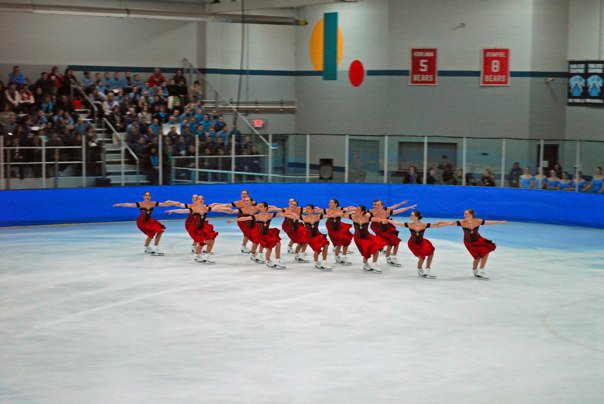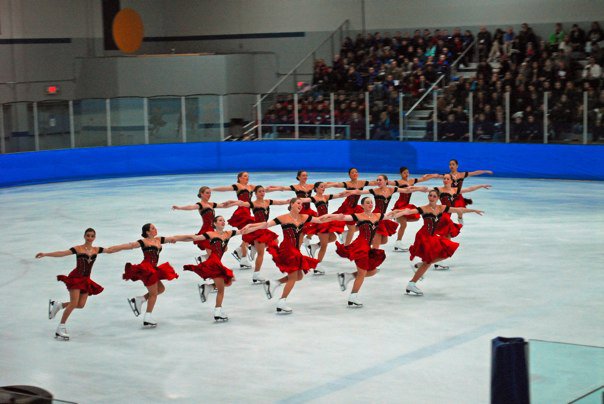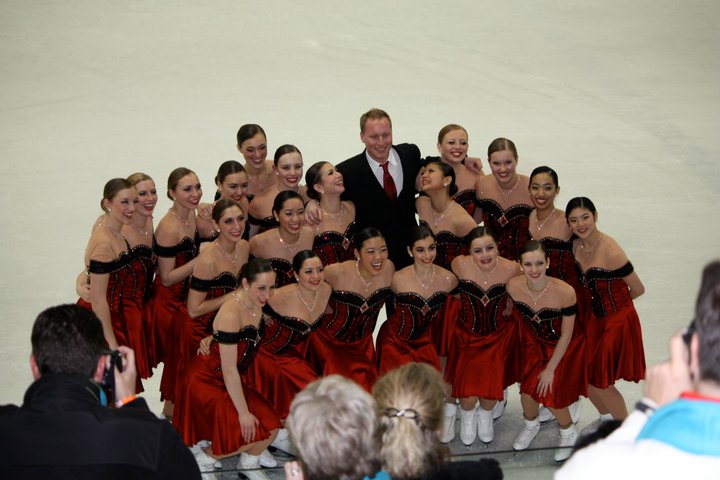by Liz Leamy
 Back in 2001, a small, but ambitious group of skating
parents from Westchester, New York thought it might be fun to put together a
synchronized skating team and in turn created the Skyliners. These individuals,
probably not realizing what sort of major organization they had just created,
organized a dozen or so skaters on the beginner field moves and freestyle test
levels to make a team that within a few months started to bring home lots of
hardware from numerous East Coast non-qualifying competitions.
Back in 2001, a small, but ambitious group of skating
parents from Westchester, New York thought it might be fun to put together a
synchronized skating team and in turn created the Skyliners. These individuals,
probably not realizing what sort of major organization they had just created,
organized a dozen or so skaters on the beginner field moves and freestyle test
levels to make a team that within a few months started to bring home lots of
hardware from numerous East Coast non-qualifying competitions.
Within a few years, the Skyliners, who are slated to perform at the 2011 U.S. Championships gala exhibition on Sunday, had managed not only to establish themselves as a first-rate team on the East Coast, but as main contenders on the U.S. synchronized skating front.
Today, the Skyliners are run much like a Fortune 500 company. The organization consists of more than 150 total skaters and appears to be growing at an exponential rate. This season, they list seven total teams on their docket, ranging all the way from Beginner to Junior. Next year, they plan on adding a senior team.
As proof of their competitive prowess, last month the junior team claimed gold at the Junior World Qualifier in Fond du Lac Wisconsin and earned a Team USA 1 berth at the Junior World Challenge Cup in Switzerland.
According to Josh Babb, the junior team head coach, the success of the team is all due to the skaterís commitment to their craft.
"To be a Skyliner you have to be committed," said Babb, a former Canadian national ice dance contender who competed on the International Skating Union Junior Grand Prix circuit.
Another reason for this teamís growth and success is due to the fact that the parents, skaters and coaches all work together well.
"The reasons for growth include competitive success, incredible coaches, dedicated skaters, families and board members," said Mary McQuade, Skyliners vice president and whose daughter Audrey, 17, skates on the junior team.
Team reflects growth in synch
 Back when the Skyliners first started out, synch was just
starting to take of in terms of its overall popularity here in the U.S. At this
stage, dozens of skaters started to participate in this discipline because they
saw it as a more viable way to achieve success and possible national competitive
status compared to singles, pairs and ice dancing. In other words, it
represented a more promising future for serious skaters who didnít possess the
skills or want to be involved in singles, pairs or ice dancing events.
Back when the Skyliners first started out, synch was just
starting to take of in terms of its overall popularity here in the U.S. At this
stage, dozens of skaters started to participate in this discipline because they
saw it as a more viable way to achieve success and possible national competitive
status compared to singles, pairs and ice dancing. In other words, it
represented a more promising future for serious skaters who didnít possess the
skills or want to be involved in singles, pairs or ice dancing events.
According to Babb, synchronized skating is most similar to ice dancing compared to all the disciplines.
"The edges, turns, lifts and style of the programs are most similar to ice dancing," he said. "The skaters have to really reach out to the audience and as a group, this kind of skating is so interesting to watch."
By the middle of the new decade of the millenium, synch had really started to explode, especially in the Westchester County area. More and more skaters began to pursue this venue and then stuck with it.
By 2010, the Skyliners and other area synch team skaters comprised the majority of club-session skaters and this group continues to expand.
According to McQuade, there are several primary reasons for the continued growth of synchronized skating in the New York-metropolitan area.
"The shared experience of competitive success on a team are very rewarding for the girls both on and off the ice," she said adding that "although expensive, itís more affordable then skating individually, especially once you hit the national and international arena."
Moreover, synch skaters seem to like the whole idea of training and competing under a team dynamic.
On the training front, the organization has also evolved. Back when the Skyliners first started, team practices were more loosely structured and would occur maybe once or twice a week for an hour or so. Today, each team trains a minimum of two to three times a week for several hours a session. At the same time, all skaters are mandated to practice two-to-four hours a week.
Babb is a big advocate of hard work and training.
"That is the key to success," he said.
Obviously, this is a effective approach. So far this year, almost every one of the Skyliner teams have won or medaled at the pre-season non-qualifying competitions, which has made them confident going into the qualifying events. (Next week, the Skyliners will compete at the Eastern Sectional Championships in Lake Placid, New York.)
For Babb, however, itís all about good skating and increasing the standard in this discipline and has managed to present his junior team this fashion. Their short program to "Donít Rain on My Parade" and "Phantom of the Opera" free skate have earned both artistic and technical acclaim.
"Weíre working really hard and it was nice to see the team earn good program component scores as well as high marks for their technical skills," said Babb.
Going into the future, the road for this organization looks optimistic. As a unit, they are hoping to continue increasing their overall technical and artistic quality at every level. This way, they will continue to contribute to the growth of this aspect of the sport.
"Synch plays a very important role in figure skating right now, and itís exciting to be part of this whole movement," said Babb.
No doubt, the Skyliners certainly seem to have put their wheels well into motion.
